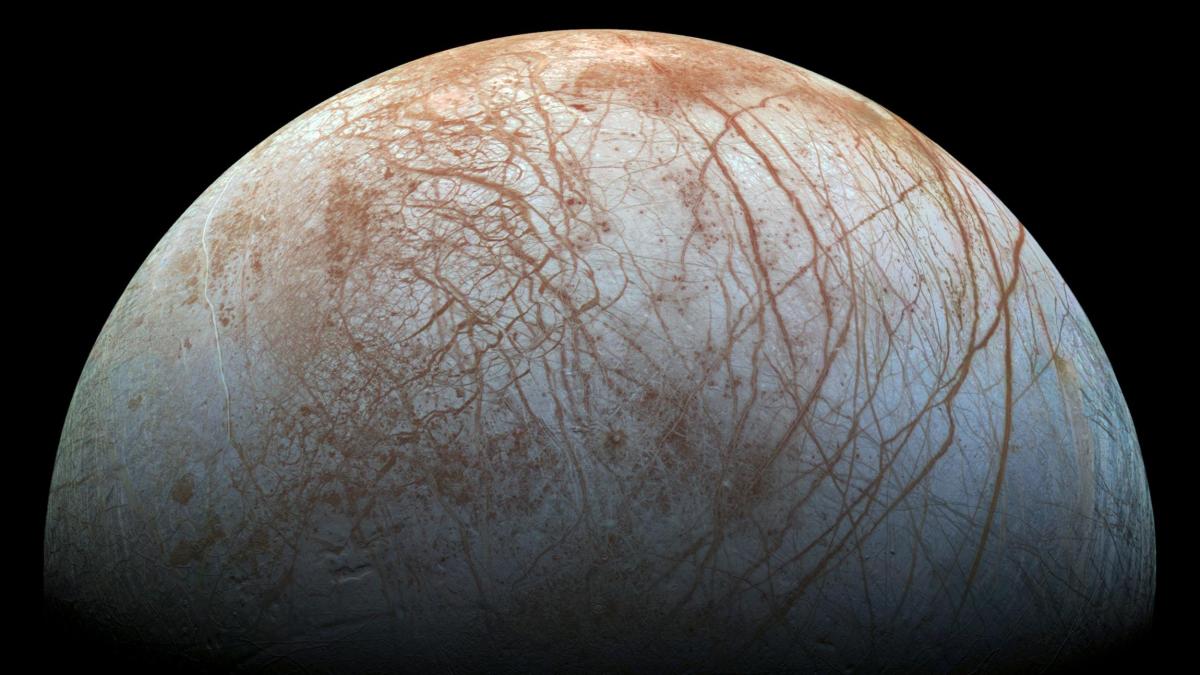jupiter’s moon europa, its icy surface criss-crossed by dark reddish-brown stripes, against the darkness of space
The core of Jupiter’s oceanic moon Europa may have formed billions of years after the others, if they did form, a new study has found.
Europe, Jupiter’s fourth largest moon, is covered in an icy shell. However, researchers suspect that beneath its frozen crust, Europa hosts a saltwater ocean that swirls above its rocky mantle. It may have “much more liquid water than Earth,” study lead author Kevin Trinh, a planetary scientist at Arizona State University in Tempe, told Space.com.
Previous research has shown that Europa is habitable — for example, seafloor volcanoes and hydrothermal vents could help transmit life-sustaining heat and biologically useful molecules into its oceans. To know what potentially life-supporting activity is occurring on Europa, scientists must understand the nature of Jupiter’s moon’s interior and how it may have evolved over time.
“While Europa is renowned as a potentially habitable ocean world, more than 90% of Europa’s mass comes from rock and metal,” Trinh said.
Related: Alien life hunters target the icy ocean moons Europa and Enceladus
After NASA’s Galileo spacecraft reached the Jovian system in 1995, analysis of Europa’s gravitational field showed that Europa’s interior, like Earth’s, is divided into a metallic core and a rocky mantle. Later studies have often assumed that Europa’s interior split into these layers when, or soon after, the Jovian moons formed.
Now, “to our surprise, we found that Europa may have spent most of its life without a fully formed metallic core – that is, if such a core actually existed,” Trinh said.
A 2021 study that re-examined Galileo’s data suggests that Europa may be less massive near its center than previously thought. This would then raise the question of whether it has a fully formed core.
One reason why Europa may not have a fully formed core is that it most likely formed at much cooler temperatures than Earth, because the cold moon is farther from the sun. This means that by the time Europa’s building blocks came together, they may not have melted and separated into a metal core and a rocky mantle.
The story continues
RELATED STORIES:
— NASA spacecraft takes beautiful new photos of Jupiter’s moons Io and Europa
— Look! Our closest view of Jupiter’s oceanic moon Europa in 22 years
— The ‘Chaos’ region of Jupiter’s icy moon Europa could increase the chances of life
Trinh and his colleagues developed a computer model of how the temperature in Europa’s interior changed over 4.5 billion years, assuming a relatively low initial temperature of minus 99 degrees Fahrenheit (minus 73 degrees Celsius) to 80 degrees F (26 degrees C).
Scientists found that, in the first 500,000 years or so after Europa’s birth, the oceans and its icy shell may have formed as a chemical reaction that caused water to gradually rise from its mantle. Europa’s metallic core, if it exists, would likely have started forming at least a billion years after the moon’s birth; heat from radioactive elements and tides from Jupiter’s gravitational pull may have melted the core slowly during Europa’s lifetime.
Europa may still be gradually separating into layers today, the researchers note. Formation of a metallic core will help make Europa more habitable, “because the formation of a metallic core can send heat waves into the rocky mantle,” Trinh said.
NASA’s planned European Cutter mission could help gravitationally scan Jovian moons to “enhance our understanding of how mass is distributed within Europa, which is related to the presence of Europa’s metallic core,” Trinh said.
The new study was published online today (June 16) in the journal Science Advances.
2023-06-18 17:04:13
#Shock #Jupiters #oceanic #moon #Europa #fully #formed #core #SurabayaPostKota.net

/data/photo/2023/06/18/648f0f623ce51.jpg?resize=150%2C150&ssl=1)
/nginx/o/2022/07/18/14704309t1hc4d4.jpg?resize=150%2C150&ssl=1)